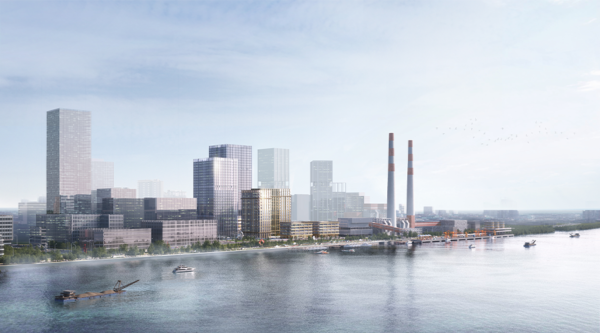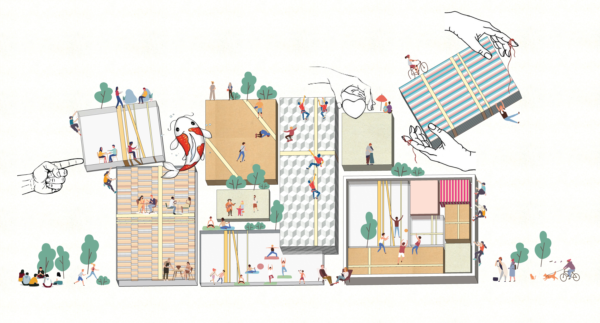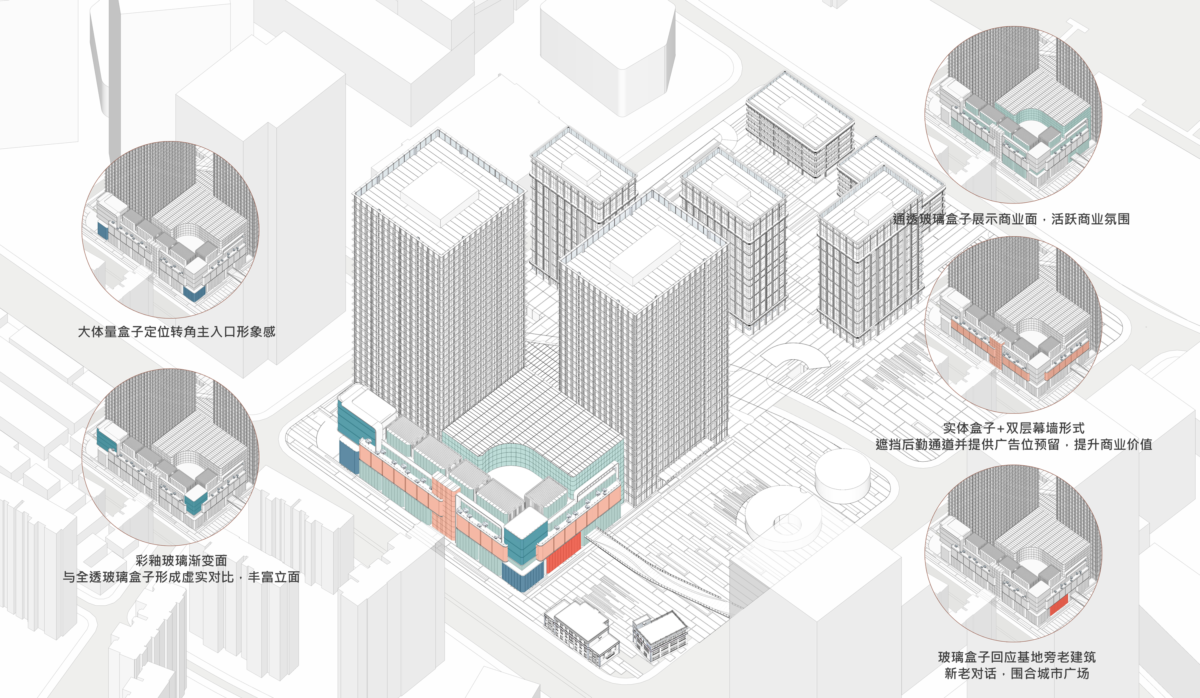New Project Spotlight: Immerse in Yangpu District’s History, Envisioning the Future along the Riverfront — Shanghai Hopson Riviera
Transforming the Landscape: Hopson Riviera’s Vision for Shanghai’s Yangpu Riverfront
The Yangpu Riverfront — The banks of the Huangpu River have always held a vital role within Shanghai’s landscape, playing a pivotal role in shaping China’s modern industrial civilization. Revered as the “corridor of modern Chinese industry”, this district has been the birthplace of numerous pioneering achievements in Chinese industrial history, including the nation’s first waterworks facility, power plant, and gasworks. In recent years, it has become a sought-after location for prominent new economy enterprises, such as Meituan and Bilibili, which have chosen to establish their headquarters here.
Benoy has partnered with Hopson Development to create a unique and visionary large-scale urban mixed-use project – the Shanghai Hopson Riviera project plot 121. This project integrates elements of “HQ office + Retail + Industry offices”, injecting a fresh surge of industry vitality into the economy while creating an eco-park “headquarters garden” adjacent to the scenic “Changyang recreational strip”.
History
This project is situated at the core of the Huangpu riverfront, which is home to historical landmarks such as the Yangshupu Power Plant, Yangshupu Waterworks, Shanghai Soap Company, and the Shanghai International Fashion Centre.
This public green space also encompasses the grounds of the former Shanghai Gas Company Huangpu Plant — an exceptional historic building now classified as a protected cultural relic of Shanghai. Constructed on February 28, 1934, the building continued its operation until 1999. The premises of the former plant includes a three-story office, residences for senior employees, as well as Shanghai’s oldest surviving gas tank.
Location
The plot is located along a prominent east-west thoroughfare on the southern side of Yangshupu Road. To its south lies the Yangpu Riverfront Park, while to its east stands the Yangshupu Power Plant restoration project. On the western flank, stands the Bilibili headquarters.
Anticipating seamless connectivity, planned subway lines 24 and 26 will meet at the intersection of Yangshupu Road and Longchang Road. This junction promises convenient access and is expected to channel pedestrian flow from the northern end of the site to the interior.
Thanks to the site’s proximity to emerging enterprises, rich historical elements, and captivating public green spaces along the river, this site — backed by the sole investment of Hopson Development Group — is poised for transformation into a dynamic multifunctional urban landmark which combines headquarter offices, the e‑sports industry, landmark retail, recreation, green spaces, public art installations, and historical sites. The result will culminate in a pivotal node in the progression of the east-west riverbank development narrative.
General plan
This project plan occupies a total area of 45,407 sqm and consists of three parcels of land designated for development: the northern plot, southern plot, and the space below Yangpu Road. The constructed structures will have a combined floor space of 259,484 sqm, offering space for headquarter offices, emerging enterprises, and high-end retail establishments.
The design of the plan follows the curvature of the river, creating a tranquil and inviting riverfront space in a tiered manner. Two towers seamlessly integrate with the Huangshupu Power Plant to form an architectural composition that contributes to the undulation of the skyline along the riverbank. The highest points of these three structures together serves as a gateway to Tengyue Road.
The landscape of Yangpu Riverbank Park and the former gasworks permeates and extends towards the business park and the fifth retail façade, creating a multi-element, multi-layered, and multi-dimensional public art space. A three-story corridor stretches across the green zone, linking the western plot of land, thereby creating a three-dimensional green landscape and a slow-moving traffic system catering to cyclists and pedestrians.
The project’s underground retail space connects with the underground retail space of Yangshupu Power Plant. Additionally, the underground spaces of both the north-south land parcel and Yangpu Road have been fully developed, effectively interconnecting the area’s retail hubs and improving the functionality of the urban space.
Offered as a ‘Gift’ to the Yangpu riverfront, an ensemble of ‘boxes’ varying in sizes is meticulously stacked in an artful arrangement: in the high floor area ratio of the northern parcel, these ‘gift boxes’ are thoughtfully repositioned along Yanshupu Road to create a façade language that extrude a dynamic, transparent, and tension-filled ambiance. Meanwhile, the southern parcel uses a ‘three-phase’ gift box enclosure layout, harmonizing the two towers to incorporate a timeless, refined and intricate design language into the Huangpu riverfront.
Headquarter Office Buildings
Within the northern plot, two 5A grade office towers soar to heights of 160m and 130m respectively, poised to become the future skyline of Huangpu riverfront. The staggered layout of the two towers serves to mitigate the visual impact they might otherwise exert on the surrounding urban space. By artfully avoiding direct lines of sight between the towers, a harmonious dialogue between the buildings is created.
In the coming years, the project is set to serve large enterprises, attracting a greater influx of high-tech and emerging industries to establish their headquarters within the Yangpu riverfront ‘headquarters park’, and serve as reserves for the times ahead.
Guided by a design vision encapsulated in the phrase ‘bridging history and envisioning the future’, the project traces the historical roots of the textile factory that once graced this site, weaving a narrative that transverses time and space, linking the industrial glory of bygone days with the emerging industry of today. The building façades employs a neat and methodical design language, accentuating the prominence of the towers while adhering to the parameters of the project plan.
The design was inspired by visuals of the former textile factory, where threads pass through combs, and vertical and horizontal metal components interweave within the façade, evoking a sense of meticulous and deliberate craftsmanship.
Industry office / Enterprise public space design
The southern plot offers corporate public spaces tailored for emerging industries. In the future, its primary focus will revolve around industries related to e‑sports and new energy.
Two office layout options are available to meet diverse business needs: the two riverfront structures can function as a unified entity, offering adaptability and exclusivity. There structures feature independent lobbies or exhibition spaces, elevators, rooftop gardens, and other facilities.
On the other hand, the north plot’s three buildings are designed to accommodate medium-sized enterprises, providing options for single or multi-floor rentals based on their requirements. These buildings offer views of the premium south-facing central gardens and the river, creating a desirable work environment.
The five towers encircle the central gardens, which are designed as the core of the land plots along with the sunken multi-functional hall. In the future, this area will cater to enterprises and commercial brands, becoming the prime location for product launches, displays, and promotions. Additionally, it will transform the Yangpu riverfront into a green urban living space —a functional complex open to the public.
The language of the entire façade extends the neat and orderly design concept of the headquarters offices while also incorporating its unique elegance, forming an urban face that is both diverse and uniform. Individual threads either stand independently or are woven together, creating a complex, multi-layered language.
Retail design
The above-ground retail consists of six floors, primarily concentrated in the north plot. These floors are dedicated to high-end retail, art, and a leisurely lifestyle. This addition will address the gap in centralized businesses within this district and serve the diverse range of customer groups, including families, white-collar workers, and tourists.
Yangshupu Road offers the main street scenery. To mitigate the impact of spatial limitations on the podium’s scale in relation to pedestrians, a variety of virtual and real ‘gifts’ are artfully stacked in an orderly manner. These elements start from the fourth floor and recede further inward with each layer, forming dining terraces that offer city views. This layout establishes a more pleasant urban scale and enriches the tapestries of street scenes. ‘Ribbons’ have been added as a finishing touch between these ‘gifts’, seamlessly connecting the scene and infusing the space with a dynamic vibrancy.
The western side of the retail podium collaborates with the historic sites within the green zone to form an enclosed historic park square that connects with the Yangpu Historic Industry Riverfront Park. This initiative introduces a fresh space where history and art converge, enriching the local experience.
The architectural design language also engages in a thoughtful dialog with history. In contrast to the uniqueness of the main façade, new materials are used to reinterpret the brick wall elements of the former gasworks. This is achieved through a fusion of glass and ceramic bricks, creating a blend of both visual illusion and tangible transformation. As a result, the retail façade exudes a sense of modernity and subtlety.
The southern side of the retail podium is fully recessed, combining a skylight and dining services. This design harmonizes with the sunken square layout of the north-south parcel to create a comfortable pedestrian zone along Yangpu Road. This integrated space combines dedicated walking paths and lanes for motorized and non-motorized vehicles.
Two underground floors have been allocated for retail, spanning around 300 m across both the north and south plots, with provisions for a grocery store. To enhance visitor engagement from the subway and riverfront, we have streamlined pedestrian flow, partnering with business owners to introduce an innovative retail concept for Hopson Riviera. This encompasses the Lohas Plaza, Hopson Paradise eco-friendly dining, Hopson Assemble co-living supermarket, and Art Plaza. Additionally, the design also includes a sunken square with a comfortable scale, seamlessly blending with the Huangpu Riverfront Park and harnessing the dynamic energy of the river.
The successful completion of the Huangpu riverfront 121 plot project is set to contribute significantly to the comprehensive transformation of the city’s business district and enhance the Daqiao East business district.
The above project is still in progress. Final plans are still subject to approval.
Project overview:
Scope of services:
Masterplanning, architecture design
Category:
TOD urban mixed-use
Client:
Hopson Development
Project scale:
Total floor area: 420,645 m²
Volumetric area: 260,418 m²
Principle project designer:
Qin Pang
Project Director:
Zhu Yejia
Project leaders:
William Zhang, Li Yawen, Hao Ding
Project design team:
Willow Liu, Chen Qidan, Nigel Wang, Xue Tielong, Huang Shixun
















































